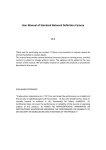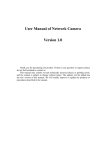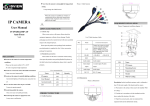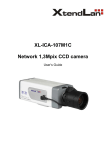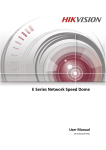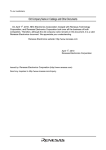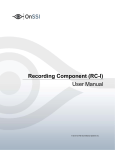Download Network Camera - Security Point
Transcript
Network Camera User Manual V2.0.0 User Manual of Network Camera 1 Thank you for purchasing our product. If there are any questions, or requests, please do not hesitate to contact the dealer. This manual applies to DS-2CD802/812/892PF(NF)(-E)(-W), DS-2CD832F(-E), DS-2CD802/812/892P(N)-IR1(IR3)(IR5), DS-2CD702/712/792PF(NF)(-E), DS-2CD732F(-E)series Network Camera This manual may contain several technical incorrect places or printing errors, and the content is subject to change without notice. The updates will be added to the new version of this manual. We will readily improve or update the products or procedures described in the manual. DISCLAIMER STATEMENT “Underwriters Laboratories Inc. (“UL”) has not tested the performance or reliability of the security or signaling aspects of this product. UL has only tested for fire, shock or casualty hazards as outlined in UL’s Standard(s) for Safety, UL60950-1. UL Certification does not cover the performance or reliability of the security or signaling aspects of this product. UL MAKES NO REPRESENTATIONS, WARRANTIES OR CERTIFICATIONS WHATSOEVER REGARDING THE PERFORMANCE OR RELIABILITY OF ANY SECURITY OR SIGNALING RELATED FUNCTIONS OF THIS PRODUCT.” User Manual of Network Camera 2 Regulatory Information FCC Information FCC compliance: This equipment has been tested and found to comply with the limits for a digital device, pursuant to part 15 of the FCC Rules. These limits are designed to provide reasonable protection against harmful interference when the equipment is operated in a commercial environment. This equipment generates, uses, and can radiate radio frequency energy and, if not installed and used in accordance with the instruction manual, may cause harmful interference to radio communications. Operation of this equipment in a residential area is likely to cause harmful interference in which case the user will be required to correct the interference at his own expense. FCC Conditions This device complies with part 15 of the FCC Rules. Operation is subject to the following two conditions: 1. This device may not cause harmful interference. 2. This device must accept any interference received, including interference that may cause undesired operation. EU Conformity Statement This product and - if applicable - the supplied accessories too are marked with "CE" and comply therefore with the applicable harmonized European standards listed under the Low Voltage Directive 2006/95/EC, the EMC Directive 2004/108/EC. 2002/96/EC (WEEE directive): Products marked with this symbol cannot be disposed of as unsorted municipal waste in the European Union. For proper recycling, return this product to your local supplier upon the purchase of equivalent new equipment, or dispose of it at designated collection points. For more information see: www.recyclethis.info. 2006/66/EC (battery directive): This product contains a battery that cannot be disposed of as unsorted municipal waste in the European Union. See the product documentation for specific battery information. The battery is marked with this symbol, which may include lettering to indicate cadmium (Cd), lead (Pb), or mercury (Hg). For proper recycling, return the battery to your supplier or to a designated collection point. For more information see: www.recyclethis.info. User Manual of Network Camera 3 Safety Warnings and Cautions Please pay attention to the following warnings and cautions: Hazardous Voltage may be present: Special measures and precautions must be taken when using this device. Some potentials (voltages) on the device may present a hazard to the user. This device should only be used by employees from our company with knowledge and training in working with these types of devices that contain live circuits. Power Supply Hazardous Voltage: AC mains voltages are present within the power supply assembly. This device must be connected to a UL approved, completely enclosed power supply, of the proper rated voltage and current. No user serviceable parts inside the power supply. System Grounding (Earthing): To avoid shock, ensure that all AC wiring is not exposed and that the earth grounding is maintained. Ensure that any equipment to which this device will be attached is also connected to properly wired grounded receptacles and are approved medical devices. Power Connect and Disconnect: The AC power supply cord is the main disconnect device to mains (AC power).The socket outlet shall be installed near the equipment and shall be readily accessible. Installation and Maintenance: Do not connect/disconnect any cables to or perform installation/maintenance on this device during an electrical storm. User Manual of Network Camera 4 Power Cord Requirements: The connector that plugs into the wall outlet must be a grounding-type male plug designed for use in your region. It must have certification marks showing certification by an agency in your region. The connector that plugs into the AC receptacle on the power supply must be an IEC 320, sheet C13, female connector. See the following website for more information http://kropla.com/electric2.htm. Lithium Battery: This device contains a Lithium Battery. There is a risk of explosion if the battery is replaced by an incorrect type. Dispose of used batteries according to the vendor’s instructions and in accordance with local environmental regulations. Perchlorate Material: Special handling may apply. See www.dtsc.ca.gov/hazardouswaste/perchlorate. This notice is required by California Code of Regulations, Title 22, Division 4.5, Chapter 33: Best Management Practices for Perchlorate Materials. This device includes a battery which contains perchlorate material. Taiwan battery recycling: Please recycle batteries. Thermal and Mechanical Injury: Some components such as heat sinks, power regulators, and processors may be hot; care should be taken to avoid contact with these components. Electro Magnetic Interference: This equipment has not been tested for compliance with emissions limits of FCC and similar international regulations. This device is not, and may not be, offered for sale or lease, or sold, or leased until authorization from the United States FCC or its equivalent in other countries has been obtained. Use of this equipment in a residential location is prohibited. This equipment generates, uses and can radiate radio frequency energy which may result in harmful interference to radio communications. If this equipment does cause harmful interference to radio or television reception, which can be determined by turning the equipment on and off, the user is required to take measures to eliminate the interference or discontinue the use of this equipment. Lead Content: Please recycle this device in a responsible manner. Refer to local environmental regulations for proper recycling; do not dispose of device in unsorted municipal waste. User Manual of Network Camera 5 Safety Instruction These instructions are intended to ensure that the user can use the product correctly to avoid danger or property loss. The precaution measure is divided into ‘Warnings’ and ‘Cautions’: Warnings: Serious injury or death may be caused if any of these warnings are neglected. Cautions: Injury or equipment damage may be caused if any of these cautions are neglected. Warnings Follow these safeguards to Cautions Follow these precautions to prevent serious injury or death. prevent potential injury or material damage. Warnings 1. In the use of the product, you must strictly comply with the electrical safety regulations of the nation and region. 2. Source with 24V AC or 12V DC according to the IEC60950-1 standard. Please refer to technical specifications for more details. 3. Do not connect several devices to one power adapter as an adapter overload may cause over-heating and can be a fire hazard. 4. Please make sure that the plug is firmly inserted into the power socket. 5. When the product is installed on a wall or ceiling, the device should be firmly fixed. 6. If smoke, odor, or noise rise from the device, turn off the power at once and unplug the power cable, then contact the service center. 7. If the product does not work properly, please contact your dealer or the nearest service center. Never attempt to disassemble the camera yourself. (We shall not assume any responsibility for problems caused by unauthorized repair or maintenance.) User Manual of Network Camera 6 Cautions 1. Make sure the power supply voltage is correct before using the camera. 2. Do not drop the camera or subject it to physical shock. 3. Do not touch CCD (Charge Coupled Device) modules with fingers. If cleaning is necessary, use a clean cloth with a bit of ethanol and wipe it gently. If the camera will not be used for an extended period of time, put on the lens cap to protect the CCD from dirt. 4. Do not aim the camera at the sun or extra bright places. A blooming or smear may occur otherwise (which is not a malfunction however), and affecting the endurance of CCD at the same time. 5. The CCD may be burned out by a laser beam, so when any laser equipment is being used, make sure that the surface of the CCD will not be exposed to the laser beam. 6. Do not place the camera in extremely hot or cold temperatures (the operating temperature should be between -10°C ~ +60°C), dusty or damp locations, and do not expose it to high electromagnetic radiation. 7. To avoid heat accumulation, good ventilation is required for a proper operating environment. 8. Keep the camera away from liquids. 9. While shipping, the camera should be packed in its original packing, or packing of the same texture. 10. Regular part replacement: a few parts (e.g. electrolytic capacitor) of the equipment should be replaced regularly according to their average life time. The average time varies because of differences between operating environment and usage history, so regular checking is recommended for all users. Please contact with your dealer for more details. 7 User Manual of Network Camera Table of Contents Chapter 1 Introduction........................................................................................................................... 8 1.1 Network camera Functions and Features..................................................................................... 8 1.2 Applications .................................................................................................................................. 9 Chapter 2 Installation ........................................................................................................................... 10 2.1 Panels Description ...................................................................................................................... 10 2.1.1 Side Elevation of the Camera ............................................................................................... 10 2.1.2 Rear Panel Description ......................................................................................................... 11 2.2 Product Installation .................................................................................................................... 14 2.2.1 Box camera Installation ........................................................................................................ 14 2.2.2 Dome camera Installation .................................................................................................... 15 2.2.3 Topological graph of network camera.................................................................................. 16 Chapter 3 Parameter Configuration ..................................................................................................... 18 3.1 Network Camera access model overview .................................................................................. 18 3.1.1 Wireless Network (Only “-w” series support) ..................................................................... 18 3.1.2 Wired network ..................................................................................................................... 19 3.2 Visit Network Camera in LAN ..................................................................................................... 19 3.3 Configuration via Web browser .................................................................................................. 19 3.4 Configuration via Client Software ............................................................................................... 24 3.5 Wireless Network Camera Access .............................................................................................. 30 3.6 Visit Network Camera via Internet ............................................................................................. 32 3.6.1 Visit network camera with static IP ..................................................................................... 32 3.6.2 Visit network camera with dynamic IP ................................................................................ 34 Appendix 1 SADP Introduction............................................................................................................. 37 Appendix 2 Port Map ........................................................................................................................... 39 Appendix 3 Pin Definition .................................................................................................................... 41 Appendix 4 Product Specification ........................................................................................................ 42 8 User Manual of Network Camera Chapter 1 Introduction Network camera is a kind of embedded digital surveillance product that combines the features of both traditional analog camera and net DVS (Digital Video Server). Due to the embedded Linux operation system and the latest Davinci hardware platform of TI, the system operates with high scheduling efficiency. Furthermore, the firmware is burned in the flash, which makes the product small, reliable and highly stable. 1.1 Network camera Functions and Features Functions: Network Function: support the TCP/IP protocols(TCP/IP,HTTP,DHCP,DNS,RTSP RTCP,PPPoE, Furthermore,FTP,SMTP,NTP,SNMP addible),and IE browsing. Heartbeat Function: The server can acquire real time operating performance of the network camera through the heartbeat function. Alarm Function: The product includes 1 channel of alarm signal input and 1 channel of alarm on/off output, and supports motion detection, video missing, mask alarm and external alarm input.(Get details in Specification) Voice Talking: Support bidirectional voice talking and monomial voice broadcasting. User Management: Support multilevel right management. The administrator can create up to 15 separate users with different right levels, which highly improves the system security. The product offers a 10M/100M self-adaptive Ethernet interface. Support set the parameters, browses real time videos or checks the camera performance through software or IE, and gets external alarming and stores the compressed bit rate through network. Support remote upgrades and maintenance. RS-485 supports monomial transparent channel function so that clients on remote PC can control the serial devices. Compression Functions: Support 1 channel video signal and 25fps in Pal (704 × 576) ,30fps in NTSC (704 × 480) real time H.264 video Encoding standard compression, which supports both variable bit rate and variable frame rate; besides, you can self-define both the video quality and its compressed bit rate. Support resolution of 4CIF (PAL:704 × 576, NTSC:704 × 480), DCIF (PAL:528 × 384, NTSC:528 × 320), 2CIF (PAL:704 × 288, NTSC:704 × 240), CIF (PAL:352 × 288, NTSC:352 × 240),QCIF (PAL:176 × 144, NTSC:176 × 120). Support resolution up to 1600×1200 Pixels for 2.0 megapixels Network Camera. Support resolution up to 1280×960 Pixels for 1.3 megapixels Network Camera. User Manual of Network Camera 9 Remote Control: The product offers a 10M/100M self-adaptive Ethernet interface. Support TCP / IP, HTTP, DNS, RTP / RTCP, PPPoE protocols. Set the parameters, browse real time videos or check the camera performance through software or IE, and get external alarming and store the compressed bit rate through network. Support remote upgrades and maintenance. RS-485 supports monomial transparent channel function so that clients on remote PC can control the serial devices. Support NAS storage. 1.2 Applications This camera is ideal for remote control network applications. E.g.: 1. Network surveillance for ATM, bank counters, supermarkets and factories. 2. Remote surveillance for nursing homes, kindergartens and schools. 3. AI janitors. 4. AI building/district management systems. 5. Self-service systems of power plants. 6. Outdoor monitoring systems for bridges, tunnels and crossroad traffic. 7. Pipelining and warehouse monitoring. 8. 24-hour monitoring for road traffic. 9. Remote monitoring of forest and water resources. 10. Surveillance for airdrome, railway station, bus stop etc. 10 User Manual of Network Camera Chapter 2 Installation Note: 1. 2. 3. 4. 5. Please check if all the items on the package list have been included with your camera. Read the following contents carefully before the installation. Make sure that all the related equipment is power-off during the installation. Check the power supply to prevent any damage caused by mismatching problems. If the product does not operate properly, please contact your dealer or the nearest service center. Never attempt to disassemble the camera yourself. Users are responsible for any problem caused by modification or repairing without authorization. 2.1 Panels Description 2.1.1 Side Elevation of the Camera Figure 2.1.1 Side Elevation of DS-2CD832 series camera Figure 2.1.2 Side Elevation of DS-2CD802, DS-2CD812, DS-2CD892 series camera 11 User Manual of Network Camera Figure 2.1.3 Side Elevation of DS-2CD702,DS-2CD712,DS-2CD732,DS-2CD792, DS-2CD752, DS-2CD762 series camera Note: The vandal proof series dome is slightly different, please refer to 2.2.3 Vandal proof dome hard installation part. 2.1.2 Rear Panel Description Figure 2.1.4 Rear Panel of DS-2CD832 series 1. Standard Ethernet (UTP) RJ45 (10M/100M self-adaptive). 2. 1 channel voice talk input,3.5mm audio interface, 2.0~2.4Vp-p, 1kΩ. 3. 1 channel voice talk output, 3.5mm audio interface, electric line level, 600Ω. User Manual of Network Camera 12 4. 1 channel alarm output (1A 1B). 1 channel alarm input signal (IN,G). RS-485 bus interface (T+ T-) (Only DS-2CD832F Support RS-485). 5. SD card slot (Support SDHC ). 6. Power supply interface of 12VDC, ±10%. Figure 2.1.5 Rear Panel of DS-2CD802, DS-2CD812 , DS-2CD892 series 1. Standard Ethernet (UTP) RJ45 (10M/100M self-adaptive). 2. 1 channel voice talk input,3.5mm audio interface, 2.0~2.4Vp-p, 1kΩ. 3. 1 channel voice talk output, 3.5mm audio interface, electric line level, 600Ω. 4. BLC, AI, AES dial switch. 5. GND. 6. VD( Video Drive), DD(Direct current Drive). 7. Video Output port. 8. SD card slot. 9. alarm output (1A 1B); RS-485 bus interface(T+ T-); Alarm input signal (IN,G). 10. Power supply interface of 12VDC, ±10%. 13 User Manual of Network Camera Figure 2.1.7 Rear Panel of DS-2CD702, DS-2CD712, DS-2CD732, DS-2CD792 series Address& protocols dial switch, define for dial switch: , from 1 to 5 dial switch function as follows: Switch 1 2 3 4 5 Function ON OFF SHARP SOFT AES AI BLC OFF FL ON NAGC SAGC Note: There are invalid dial switches for DS-2CD702, DS-2CD712, DS-2CD792, DS-2CD732 series from 6 to 10; 14 User Manual of Network Camera Figure 2.1.8 Rear Panel of DS-2CD802/812/892P-IR1/3/5 series camera 1. A: UTP interface; 2. B: voice input interface; 3. C: voice output interface; 4. D: T+,T- means RS-485 interface; G, IN means alarm input interface; 1A,1B means alarm output interface; 5. E: BNC video output interface; 6. F: power supply input interface; Note: The rear panel of vandal proof dome is slightly different, please make the object as the standard 2.2 Product Installation 2.2.1 Box camera Installation Box camera can be fixed in both metope and ceiling. Customers can choose whichever way according to their specific needs. Please follow the steps below:(Take fixing in ceiling as an example, fixing in metope follows the same rule).Choose the fixing method and fix the camera bracket accordingly. If it is metope, then you need to fix the expand bolt (note: the mounting hole of the expand bolt should align with the bracket) before fixing the bracket. If the wall surface is wooden, the first step can be ignored and you can use the self-tapping screw to directly fix the bracket. Please note that the metope on which the camera is fixed should be able to bear at least three times the weight of the bracket and the camera. Figure 2.2.1 Fix Ceiling Bracket Figure 2.2.2 Fix Camera 15 User Manual of Network Camera Figure 2.2.3 Fix Lens 2.2.2 Dome camera Installation Dome camera can be installed include hold equipment, ceiling mounted, cylinders and other styles. Client can be installed in accordance with their own ways to achieve the installation.Please according the following specific steps to install (take ceiling mounted as example), when the wall is wood, use the self-tapping screws to fix the ceiling plate to the wall surface. Figure 2.2.4 Fix card Figure 2.2.5 Fix in Ceiling Take the three columns of Dome camera insert in the three fix slot of the ceiling plate. Pay attention to the direction of insertion. Let the ceiling plate “I” logo and the Dome camera “I” logo in the same direction. Meanwhile, make the Dome camera along the counterclockwise Rotate 15 degrees until the switch to the fixed date. At the same time, the “I” signs on the Dome camera and the locking screw on the ceiling plate is alignment. Then screw down the locking screw on the Ceiling plate. 16 User Manual of Network Camera Figure 2.2.6 Dome camera fixing Figure 2.2.7 Dome camera fixed 2.2.3 Topological graph of network camera Take DS-2CD802/812/892PF-E series for example: Figure 2.2.11 Topological Graph of Network Camera Physical Interface UTP Network Interface Connection Connect to network devices, such as switch , HUB, etc. Please refer to Appendix B for pin Definition. 17 User Manual of Network Camera Audio Input(AIN) Connect to audio input devices such as active tone (2.0~2.4Vp-p, 1kΩ) Audio Output(AOUT) Connect to sounders like loudhailer 600Ω. Power Supply(DC12V) Please refer to the appendix for specified types. Please use a matched regulator. Alarm Output(1A 1B) 1 channel alarm out. Please refer to Section 2.3.2 for connecting instructions. (external series-wound power shall be under 12V DC / 30mA) Alarm Input(IN G) 1 channel alarm in. RS-485 Interface(T+ T-) Connect to RS-485 devices like PTZ. SD card slot Insert an SD card for local storage. Video Output(VOUT) Standard BNC, connect to monitor. Note: Figure 2.2.12 Alarm output The alarm output is an on/off output that requires external power supply on connection. The external power supply shall be 12V DC/30mA, or use AC with external relays. Equipment damage or electric shock may cause if without relays. 18 User Manual of Network Camera Chapter 3 Parameter Configuration There are several network parameters of the camera which need to be set after the hardware installation. Those parameters including IP address, subnet mask and port number, etc. can be set through various kinds of methods, 2 of which are introduced as below. 1. Set the camera parameters via IE. 2. Set the camera parameters through the client software. Please make sure that the PC and network camera are connected and can ping successfully before the parameter setting. 3.1 Network Camera access model overview 3.1.1 Wireless Network (Only “-w” series support) Type 1: Point to Point Cennect Model In this model, the camera is connected to the PC on wireless network directly. Figure 3.1.1 Point to Point connection Type 2: Integrated connection In this model, the camera is connected to the wireless access point. 19 User Manual of Network Camera Figure 3.1.2 Connection through wireless access point 3.1.2 Wired network There are two ways of connecting between IPC and PC as below: Figure 3.1.3 Cross Line Connection Figure 3.1.4 Direct Line Connection 3.2 Visit Network Camera in LAN he following figures show the two ways of cable connection of a network camera and a computer: Purpose: To test the network camera, you can directly connect the network camera to the computer with a network cable as shown in Figure 2-1. Refer to the Figure 2-2 to set the network camera over the LAN via a switch or a router. 20 User Manual of Network Camera Figure 1-1 Connecting Directly Figure 1-2 Connecting via a Switch or a Router 1.1.2 Detecting and Changing the IP Address You need the IP address to visit the network camera. Steps: 1. To get the IP address, you can choose either of the following methods: Use SADP, a software tool which can automatically detect the online network cameras in the LAN and list the device information including IP address, subnet mask, port number, device serial number, device version, etc., shown in Figure 2-3. Use the client software to list the online devices. Please refer to the user manual of client software for detailed information. 2. Change the IP address and subnet mask to the same subnet as that of your computer. 3. Enter the IP address of network camera in the address field of the web browser to view the live video. Notes: The default IP address is 192.0.0.64 and the port number is 8000. The default user name is admin, and password is 12345. For accessing the network camera from different subnets, please set the gateway for the network camera after you logged in. For detailed information, please refer to Section 5.3.1 Configuring TCP/IP Settings. 21 User Manual of Network Camera Figure 1-3 SADP Interface 3.3 Configuration via Web browser Before visit the camera via web browser, user should adjust security level. Open the web browser, and enter the menu “Tool/ internet option/Security/Custom level”, then set the security level to Security Level –Low, or enable ActiveX Control and the Plug-in directly. Figure 3.3.1 gives you a visual illustration. After you can see the camera video, recover the security level for security. 22 User Manual of Network Camera Figure 3.3.1 Set the Security Level The default IP of the camera is 192.0.0.64 with 8000 as the default port, admin as the administrator, 23 User Manual of Network Camera and 12345 as the password. The administrator can create up to 15 separate operators with different right levels. To login the camera through IE, input the IP address in the address column, and the “Login” dialog box will pop-up as Figure 3.3.2. Input your user name and password, and then click “Login” to enter the “preview” page. Double click the “Camera 01” channel or “Preview” button to preview the video as Figure 3.3.3. Right click the “Camera 01” channel, and the “Main Stream”, “Sub Stream” and “Open sound” options will popup. Select the Open sound option if you connect a pickup to the camera. Figure 3.3.2 Login Interface Figure 3.3.3 Preview Interface The “Playback” and “Log” functions can be used only in the condition of existing SD card. To set the camera parameters through IE browser, click “Config” and wait for the “Remote Parameters Config” 24 User Manual of Network Camera dialog box to pop up, and then set the parameters like IP address, etc. for your demand as Figure 3.3.4. Enter the menu by invoking the 95th preset. Select the function you want by clicking the direction key. Click the IRIS+ button you can enter the submenu. The menu operation is like the remote control. Note: If plug the SD card into the camera, user should enter the “config” and select “other function” to format the SD card. For more specific information of “Remote Parameters Config”, please refer to “iVMS-4000(v2.0) introductor.pdf”. Instructions can be found in the client software iVMS-4000(v2.0) in the path of “Start”-> “All Programs”-> “iVMS 4000(v 2.0)” after installation. Figure 3.3.4 Remote Parameters Configuration 3.4 Configuration via Client Software Please refer to “iVMS-4000(v 2.0) introductor.pdf” for detailed client software installation. You can find the document in the PC Operating System after the installation of client software 4000 v 2.0 by selecting “Start”-> “All Programs”-> “iVMS 4000( v 2.0)” -> “iVMS 4000( v 2.0) introductor”. After the installation of client software-4000(v2.0), there is a short-cut icon named “Client Software-4000(v2.0)” on computer’s desktop. Please double click client software icon, a message box of “Register Administrator” as Figure 3.4.1 will appear the first time running. Password should 25 User Manual of Network Camera be more than 6 digits for registration. Note: Please keep the user name and password in mind .You will not be able to get access the software without the proper login information. Figure 3.4.1 Register Administrator Enter the registered user name and password as Figure 3.4.2. Click “Login” to enter the “Preview” menu as Figure 3.4.3. Figure 3.4.2 User Login Figure 3.4.3 Preview Menu 26 User Manual of Network Camera Click the “Configure” button in Figure 3.4.4, and then right click the blank white space. Click the “Add Area” button, and the “Add Area” message will pop up. Figure 3.4.4 Add Area Figure 3.4.5 Add Area Properties Input the area name (you can create whatever name you like) and click “OK” as Figure 3.4.6. Then right click the area you have just created as Figure 3.4.7. 27 User Manual of Network Camera Figure 3.4.6 Area Name Adding Completed Figure 3.4.7 Right Click the Area Name Click “Add Device”, and the “Add Device” dialog box will pop up as Figure 3.4.8. Input your “Device Name”. Select “Normal” from “Register” option. Input your camera IP in “Device IP”, e.g. 192.0.0.64; “User Name”: admin, “Password”: 12345, and 8000 for the default “Port”, and then modify “Channel” to 1. Click the “OK” button as Figure 3.4.8. 28 User Manual of Network Camera Figure 3.4.8 Add Device Figure3.4.9 Camera Adding Completed Click the “Preview” button to enter the “Preview” menu as Figure 3.4.10. Double click the channel name in the left tree to preview the camera feed. 29 User Manual of Network Camera Double click the channel Figure 3.4.10 Preview Menu Please refer to “Client Software-4000(v2.0)_ENG.pdf” for a more detailed parameters configuration. You can find the document in the PC Operating System after the installation of client software 4000 v. 2.0 by selecting “Start”-> “All Programs”-> “client software 4000 v. 2.0”. Figure 3.4.11 Remote Configuration 30 User Manual of Network Camera 3.5 Wireless Network Camera Access Note: The following message only introduces the –W series wireless IP camera. Take the IE Browser Access for example. Before configure parameters of the wireless IP camera, you should set the wireless router. The following example is TP-LINK. Firstly configure the ‘network parameter’ of the ‘LAN setting’ and ‘WAN setting’ in the wireless router’s management page. Enter the ‘Wireless Parameter’, and set the ‘SSID NO.’, ‘Frequency band’ and ‘Mode’. User can input any letter and number in the ‘SSID NO.’ . ‘Frequency Band’ is selected according to the on-the-spot environment, and usually we recommend 6 frequency band; Select the ’54 Mbps(802.11g)’. Select the ‘Enable Wireless Function’ and ‘Allow SSID Broadcast’. User can select ‘Enable Security Function’ according to the on-the-spot environment. You can select the ‘Security Type’, ‘Security Option’, ‘Key Mode Option’ and ‘Key Content’. Please refer to the introduction of the wireless router to get the detailed configuration. As shown: Figure 3.5.1 Router wireless parameter configuration 31 User Manual of Network Camera There are two network cards in the wireless IP camera: cable network card and wireless network card. The default IP of the cable network card is 192.0.0.64 with 8000 as the default port, admin as the administrator, and 12345 as the password. The wireless network card’s default IP is 192.168.1.64. If users configure the wireless parameters through client software, enter the remote setting interface first. After entering the remote parameter settings interface, select "WiFi parameters"-> "WiFi Settings" to enter the WiFi settings interface, as shown in figure 3.5.2. Figure 3.5.2 WiFi Settings Interface In the WiFi settings interface, if user select Ad-Hoc mode as the operating mode, please set the PC's wireless IP address in the same network segment as the IP address of wireless network camera. Select "Manage Wireless Networks" in the computer's "Network and Internet". Find the device which has the same name as the SSID number of the wireless camera. Then point-to-point communication through wireless network is established successfully. So, there is no need to use an Access Point (AP) between the PC and wireless network camera. If users need to enable encryption, select the appropriate encryption type and set the corresponding encryption parameters. In the remote parameter settings interface, select "WiFi parameters"-> "Wlan Settings" to enter the Wlan settings interface, as shown in Figure 3.5.3. 32 User Manual of Network Camera Figure 3.5.3 Wlan Settings Interface In the "Wlan settings" interface, user can set the wireless network camera's parameters like wireless IP address, subnet mask, gateway and DNS server address, etc. Unplug the network cable from wireless network camera. The wireless network camera now can be accessed through wireless network after the related network parameters have been set. The way that accesses to wireless network camera through wireless network is similar to cable network. 3.6 Visit Network Camera via Internet 3.6.1 Visit network camera with static IP When there is a static IP from an ISP, open some ports (such as 80 and 8000 ports) in the router. Then a user can visit it through a web browser or client software via the internet. The steps for port forwarding are different for each model of router. Please call the router manufacturer for assistance with port forwarding or visit www.portforward.com. Note: Refer to Appendix 2 to for a detailed explanation about Port Map. Users can directly connect the network camera to the internet without using a router. 33 User Manual of Network Camera Figure 3.6.1 Static IP through Router access IPC Figure 3.6.2 Static IP access IPC directly For the client software to view the camera, in the adding equipment column, select the normal model, and fill in the IP info. Figure 3.6.3 Selecting Normal Mode 34 User Manual of Network Camera 3.6.2 Visit network camera with dynamic IP Figure 3.6.4 Visit camera through PPPoE dail-up This camera supports the PPPoE auto dial-up function, connecting the camera to a Modem for dial-up access to an ADSL network to get a public IP address; First, through local network access to the network camera, select “Configure””Right Click the Device”, Select “Remote Configuration”, Select “PPPoE Settings” under “Network Paramters” fill in the PPPoE user name and password and confirm the password. Please restart the network camera after completion of configuration. Then the network camera can obtain a dynamic IP from an ISP operation business. However, the obtained IP address is dynamically assigned via PPPoE, so the IP address always changes accompanied with modem rebooting. Figure 3.6.5 PPPoE configuration dialog box It is inconvenient to view a network camera with a dynamic IP, therefore, users should register with a dynamic DNS service provider. (Such as DynDns.com) Domain name resolution contains normal domain name resolution and private domain name 35 User Manual of Network Camera resolution. First, we will introduce normal domain name resolution. 1. Normal Domain Name Resolution Figure 3.6.6 Normal Domain Name Resolution Apply a domain name from a domain name provider, then view the camera via the applied domain name. If the camera connects to the internet via a router, users should port forward the router. Please refer to Appendix 2. Input domain names in the client software or IE to view the network cameras. Take the client software configuration as an example. Figure 3.6.7 Selecting Normal Domain Mode 36 User Manual of Network Camera 2. Private Domain Name Resolution Figure 3.6.8 Private Domain Name Resolution A PC with a static IP which is running the domain name resolution service is necessary. When the network camera connects to the internet through PPPoE and obtains an IP address, it will send its name and IP address to the resolution server. When the client software connects to the network camera, it will connect to the resolution server and tell the resolution server the expected camera’s name. And the server will find the camera from all the registered cameras and send its IP address to the client software. Once the client software gets the IP address, it can connect the network camera. Figure 3.6.9 Selecting Private Domain Mode 37 User Manual of Network Camera Appendix 1 SADP Introduction Description of SADP V 2.0 SADP (Search Active Devices Protocol) is a kind of user-friendly and installation-free online device search tool. It searches the active online devices within your subnet and displays the information of the devices. You can also modify the basic network information of the devices using this software. Search active devices online Search online devices automatically After launch the SADP software, it automatically searches the online devices every 15 seconds from the subnet where your computer locates. It displays the total number and information of the searched devices in the Online Devices interface. Device information including the device type, IP address, port number, gateway, etc. will be displayed. Note: Device can be searched and displayed in the list in 15 seconds after it went online; it will be removed from the list in 45 seconds after it went offline. Search online devices manually You can also click to refresh the online device list manually. The newly searched devices will be added to the list. Note: You can click or on each column heading to order the information; you can click expand the device table and hide the network parameter panel on the right side, or click the network parameter panel. to to show 38 User Manual of Network Camera Modify network parameters Steps: 1. Select the device to be modified in the device list and the network parameters of the device will be displayed in the Modify Network Parameters panel on the right side. 2. Edit the modifiable network parameters, e.g. IP address and port number. 3. Enter the password of the admin account of the device in the Password field and click changes. Restore default password Steps: 1. Contact our technical engineers to get the serial code. Note: Serial code is a series of characters combined by the start time and the serial number of the device. 2. Input the code in the Serial code field and click to restore the default password. to save the 39 User Manual of Network Camera Appendix 2 Port Map Note: The following setting is about TP-LINK router (TL-R410), which is maybe distinct from other router’s setting. 1. Firstly, select the router’s WAN connection Type. As the following Figure shows: 2. Set the “network parameter” of the router as the below figure. The setting includes subnet mask and gateway. 3. Set the port map in the virtual severs of Forwarding. By default, camera uses port 80, 8000, 554 and 8200. You can change these ports value with IE or client software. The following figure gives the illustration. One camera’s ports are 80, 8000, 554, 8200 and its IP address is 192.168.1.23. The other camera’s ports are 81, 8001, 555, 8201 and IP is 192.168.1.24. Afterwards, enable all or TCP protocols. Enable the port map after pressing the ‘Save’. User Manual of Network Camera 40 As the above mentioned setting, we map the router’s port 80, 8000, 554, 8200 to the network camera 192.168.1.23; and port 81, 8001, 555, 8201 to the network camera 192.168.1.24. In this way, user can visit the 192.168.1.23 through visiting the router’s port 80, 8000, 554 and 8200. Note: The port of the network camera cannot conflict with other ports. For example, some router’s web management port is 80. User can amend the router’s or the camera’s port to solve this problem. User Manual of Network Camera Appendix 3 Pin Definition (1)UTP between the network port of camera and HUB (Direct Cable) (2)UTP between the network port of camera and PC (Cross Cable): 41 42 User Manual of Network Camera Appendix 4 Product Specification DS-2CD802/812/892/PF(NF)(-E)(-W) Specification Model Parameter DS-2CD802PF (NF) (-E) (-W) (-D) DS-2CD812PF (NF) (-E) (-W) (-D) DS-2CD892PF (NF) (-E) (-W) (-D) 420 TVL CCD Network Box Camera 480 TVL CCD Network Box Camera 540 TVL CCD Network Box Camera Camera Image Sensor 1/3” SONY CCD Signal System PAL/NTSC Min. Illumination 0.1 Lux @ (F1.2, ACG ON) Shutter Time 1/50 (1/60) s to 1/100,000 s Lens Mount C/CS mount Auto Iris DC/Video Day & Night Electronic Horizontal Resolution 420 TVL 480 TVL 540 TVL Compression Standard Video Compression Bit Rate Audio Compression Dual Stream H.264 (MPEG-4 optional) 32 Kbps - 8 Mbps OggVorbis Yes Image Max. Image Resolution Frame Rate Image Settings PAL: 704 × 576 NTSC: 704 × 480 50 HZ: 25 fps (704 × 576) 60 HZ: 30 fps (704 × 480) Saturation, Brightness, Contrast adjustable through client software or web browser Network Alarm Trigger Motion detection Protocols TCP/IP, HTTP, DHCP, DNS, RTP/RTCP, PPPoE (FTP, SMTP, NTP, SNMP optional) Security Password protection Interface Audio Input Audio Output Communication Interface 1-ch, 3.5 mm audio interface (2.0 - 2.4 Vp-p, 1 kΩ) 1-ch, 3.5 mm audio interface (Line level, 600 Ω) 1 RJ45 10 M/100 M Ethernet port and 1 RS-485 interface 43 User Manual of Network Camera Alarm Input 1 Alarm Output 1 Video Output 1Vp-p composite output (75 Ω/BNC) Local Storage Built-in SD/SDHC slot, up to 32 GB General Operating Conditions -10 °C – 60 °C (14 °F – 140 °F) Humidity 90% or less (non-condensing) Power Supply 12 V DC ± 10% PoE (802.3af) Power Consumption Max. 4 W -W: Max. 5.5 W Dimension Weight 63 x 67 x 125 mm (2.48” x 2.64” x 4.92”) 650 g (1.43 lbs) Dimension Unit: mm 44 User Manual of Network Camera DS-2CD832F(-E) Specification Parameter Model DS-2CD832F (-E) 4 CIF CMOS IP Box Camera Camera Image Sensor Min. Illumination Lens Mount Auto Iris Day & Night 1/4” CMOS 0.4 Lux @ (F1.2, AGC ON) C/CS mount --Electronic Compression Standard Video Compression Bit Rate Audio Compression Dual Stream H.264 (MPEG-4 optional) 32 Kbps - 8 Mbps OggVorbis Yes Image Max. Image Resolution Frame Rate Image Settings 704 × 576 25 fps (704 x 576) Saturation, Brightness, Contrast adjustable through client software or web browser Network Alarm Trigger Motion detection Protocols TCP/IP, HTTP, DHCP, DNS, RTP/RTCP, PPPoE (FTP, SMTP, NTP, SNMP optional) Security Password protection Interface Audio Input Audio Output Communication Interface 1-ch, 3.5 mm audio interface (2.0 - 2.4 Vp-p, 1 kΩ) 1-ch, 3.5 mm audio interface (Line level, 600 Ω) 1 RJ45 10 M/100 M Ethernet port and 1 RS-485 interface Alarm Input 1 Alarm Output 1 Local Storage Built-in SD/SDHC slot, up to 32 GB General Operating Conditions -10 °C – 60 °C (14 °F – 140 °F) Humidity 90% or less (non-condensing) Power Supply 12 V DC ± 10% Power Consumption Max. 3 W MAX Dimension Weight 63 x 67 x 128 mm (2.48” x 2.64” x 5.04”) 650 g (1.43 lbs) 45 User Manual of Network Camera Dimension Unit: mm 46 User Manual of Network Camera DS-2CD802/812/892P(N)-IR1(IR3)(IR5) Specification Model Parameter DS-2CD802P(N)-IR1(IR3)(IR 5) DS-2CD812P(N)-IR1(IR3)(IR 5) DS-2CD892P(N)-IR1(IR3)(IR 5) 420 TVL CCD Infrared Weather-proof Network Box Camera 480 TVL CCD Infrared Weather-proof Network Camera 540 TVL CCD Infrared Weather-proof Network Camera Camera Image Sensor 1/3” SONY CCD Signal System PAL/NTSC Min. Illumination 0.1Lux @(F1.2,AGC ON),0 Lux with IR 0.2Lux @(F1.8,AGC ON),0 Lux with IR Shutter Time 1/50 (1/60) s to 1/100,000 s Lens “-IR1” series: 6 mm @ F1.8 (2.8 mm, 3.6 mm optional), angle of view: 47° (6 mm) “-IR3” series: 12 mm @ F1.8 (3.6 mm, 6 mm, 8 mm,16 mm optional) , angle of view: 22.72° (6 mm) “-IR5” series: 16 mm @ F1.8 (3.6 mm, 6 mm, 8 mm,12 mm optional) , angle of view: 16.4° (6 mm) Lens Mount M12 Day & Night Electronic Horizontal Resolution 420 TVL 480 TVL 540 TVL Compression Standard Video Compression Bit Rate H.264 (MPEG-4 optional) 32 Kbps - 8 Mbps Audio Compression OggVorbis Dual Stream Yes Image Max. Image Resolution PAL: 704 × 576 NTSC: 704 × 480 Frame Rate 50 HZ: 25 fps (704 × 576) 60 HZ: 30 fps (704 × 480) Image Settings Saturation, Brightness, Contrast adjustable through client software or web browser Network Alarm Trigger Motion detection Protocols TCP/IP, HTTP, DHCP, DNS, RTP/RTCP, PPPoE (FTP, SMTP, NTP, SNMP optional) Security Password protection Interface 47 User Manual of Network Camera Audio Input Audio Output Communication Interface 1-ch, 3.5 mm audio interface (2.0 - 2.4 Vp-p, 1 kΩ) 1-ch, 3.5 mm audio interface (Line level, 600 Ω) 1 RJ45 10 M/100 M Ethernet port and 1 RS-485 interface Alarm Input 1 Alarm Output 1 Video Output 1Vp-p composite output (75 Ω/BNC) General Operating Conditions -10 °C – 60 °C (14 °F – 140 °F) Humidity 90% or less (non-condensing) Power Supply 12 V DC ± 10% Power Consumption “-IR1” series: Max. 5.5 W “-IR3” series: Max. 7 W “-IR5” series: Max. 9 W Weather Proof Rating IP66 IR Range Dimension Weight “-IR1” series: within 20 meters “-IR3” series: wthin 40 meters “-IR5” series: within 60 meters 86.5 × 83.1 × 228.4 mm (3.41” × 3.27” × 8.99”) 1400 g (3.09 lbs) Dimension Unit: mm 48 User Manual of Network Camera DS-2CD702/712/792PF (NF)(-E) Specification Parameter Model DS-2CD702PF (NF) (-E) DS-2CD712PF (NF) (-E) DS-2CD792PF (NF) (-E) 420 TVL CCD Network Dome Camera 480 TVL CCD Network Dome Camera 540 TVL CCD IP Dome Camera Camera Image Sensor 1/3” SONY CCD Signal System PAL/NTSC Min. Illumination 0.1 Lux @ (F1.2, AGC ON) Shutter Time 1/50 (1/60) s to 1/100,000 s 3.5 – 9 mm @ F1.2 Lens Angle of view: 80° - 30° Lens Mount Φ14 Auto Iris Angle Adjustment --Pan: 0 - 355°, Tilt: 0 - 75°, Rotation: 0 - 180° Day & Night Horizontal Resolution Electronic 420 TVL 480 TVL 540 TVL Compression Standard Video Compression Bit Rate Audio Compression Dual Stream H.264 (MPEG-4 optional) 32 Kbps - 8 Mbps OggVorbis Yes Image Max. Image Resolution Frame Rate Image Settings PAL: 704 × 576 NTSC: 704 × 480 50 HZ: 25 fps (704 × 576) 60 HZ: 30 fps (704 × 480) Saturation, Brightness, Contrast adjustable through client software or web browser Network Alarm Trigger Motion detection Protocols TCP/IP, HTTP, DHCP, DNS, RTP/RTCP, PPPoE (FTP, SMTP, NTP, SNMP optional) Security Password protection Interface Audio Input Audio Output Communication Interface Alarm Input 1-ch, 3.5 mm audio interface (2.0 - 2.4 Vp-p, 1 kΩ) 1-ch, 3.5 mm audio interface (Line level, 600 Ω) 1 RJ45 10 M/100 M Ethernet port and 1 RS-485 interface 1 49 User Manual of Network Camera Alarm Output 1 Video Output 1Vp-p composite output (75 Ω/BNC) Local Storage Built-in SD/SDHC slot, up to 32 GB General Operating Conditions Power Supply Power Consumption Dimension Weight -10 °C – 60 °C (14 °F – 140 °F) Humidity 90% or less (non-condensing) 12 V DC ± 10% PoE (802.3af) Max. 4 W Φ 145 × 132.8 mm (Φ 5.71” × 5.23”) 900 g (1.98 lbs) Dimension Unit: mm 50 User Manual of Network Camera DS-2CD732F(-E) Specification Parameter Model DS-2CD732F (-E) 4 CIF CMOS IP Dome Camera Camera Image Sensor Min. Illumination Shutter Time Lens Lens Mount Angle Adjustment Day & Night 1/4” CMOS 0.4Lux @(F1.2,AGC ON) 0.7Lux @(F1.6,AGC ON) 1/50 (1/60) s to 1/100,000 s 4 – 9 mm @ F1.6 Angle of view: 56° - 22.8° M12 Pan: 0 - 355°, Tilt: 0 - 75°, Rotation: 0 - 180° Electronic Compression Standard Video Compression Bit Rate Audio Compression Dual Stream H.264 (MPEG-4 optional) 32 Kbps - 8 Mbps OggVorbis Yes Image Max. Image Resolution Frame Rate Image Settings 704 × 576 25 fps (704 × 576) Saturation, Brightness, Contrast adjustable through client software or web browser Network Alarm Trigger Motion detection Protocols TCP/IP, HTTP, DHCP, DNS, RTP/RTCP, PPPoE (FTP, SMTP, NTP, SNMP optional) Security Password protection Interface Audio Input Audio Output Communication Interface 1-ch, 3.5 mm audio interface (2.0 - 2.4 Vp-p, 1 kΩ) 1-ch, 3.5 mm audio interface (Line level, 600 Ω) 1 RJ45 10 M/100 M Ethernet port and 1 RS-485 interface Alarm Input 1 Alarm Output 1 Video Output 1Vp-p composite output (75 Ω/BNC) Local Storage Built-in SD/SDHC slot, up to 32 GB General Operating Conditions Power Supply -10 °C – 60 °C (14 °F – 140 °F) Humidity 90% or less (non-condensing) 12 V DC ± 10% 51 User Manual of Network Camera PoE (802.3af) Power Consumption Dimension Weight Max. 3 W Φ 145 × 132.8 mm (Φ 5.71” × 5.23”) 900 g (1.98 lbs) Dimension Unit: mm





















































